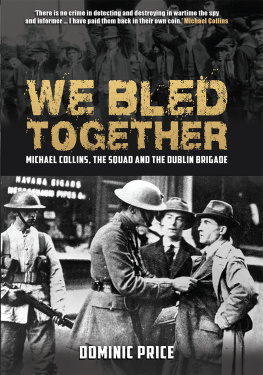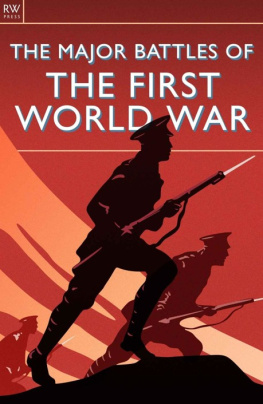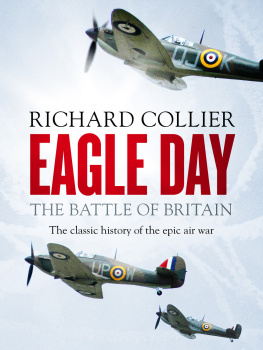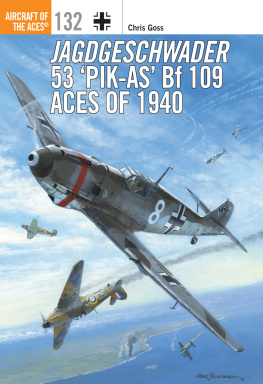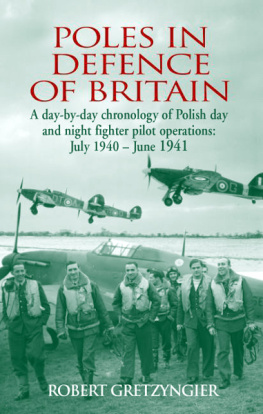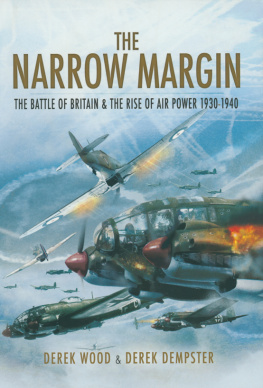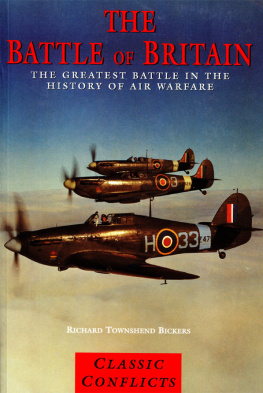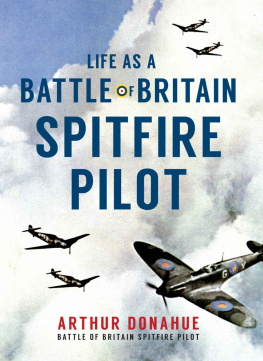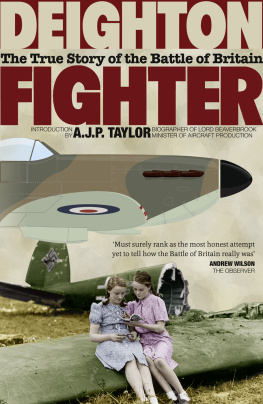Battle of Britain Day
Alfred Price
Copyright Alfred Price 1990
The right of Alfred Price to be identified as the author of this work has been asserted by him in accordance with the Copyright, Designs and Patents Act, 1988.
First published in the United Kingdom in 1990 by Sidgwick & Jackson Ltd.
This edition published in 2018 by Lume Books.
Table of Contents
Prologue
Sixteen thousand feet above the London borough of Brixton, 12.09 p.m. Throttle wide open and overtaking rapidly. Flight Lieutenant Peter Brothers of No. 257 Squadron swung his Hurricane into a firing position close behind one of the Dorniers at the rear of the German formation. Strung out behind in echelon to starboard, the other four pilots of his section followed. A 22-year old from Kent, Brothers already had eight aerial victories to his credit. Now he placed the glowing graticule of his sight over the bomber he had chosen as target, yanked the wings level and squeezed the firing button. Emitting a crackle like the tearing of calico, the fighters guns spewed armour-piercing, incendiary and tracer rounds at a rate of 150 per second. Eight smoking fingers of bullets converged on the bomber.
Yet this action was not one-sided. Bright sparks of tracer streaked past the leading Hurricane as the German gunners enmeshed their assailant in a cross-fire. Brothers felt his plane take hits. The fire was coming not so much from the aircraft I was going for, but from the chaps to the right of him. But I didnt notice any immediate effect on handling so I continued with my attack. After a short burst Brothers pulled sharply away from his victim, diving to clear the way for the second section of four Hurricanes to attack. Then the squadron split into ones and twos and the planes pulled round for further attacks on the bombers. More than a hundred British fighters were in the vicinity of the Dornier formation, buzzing round the bombers like angry wasps defending their nest.
The raiding formation comprised twenty-four Dorniers of Bomber Geschwader 76, one of them piloted by Feldwebel Wilhelm Raab. Raab, a 25-year-old from Dresden, had fought over Poland and France and was now on his 44th combat mission. He had flown fifteen times against England but had never encountered such determined fighter opposition. Since passing over Ashford, about twenty minutes earlier, his unit had come under repeated attack. Now the enemy planes were charging through the formation with unprecedented ferocity. Raab concentrated on holding the plane straight and level for the final part of the bombing run, while behind him in the bombers cramped cabin his gunners loosed off burst after burst at their tormentors. The Dorniers let go of their bombs, then, their task complete, the planes dropped their left wings and began a sweeping turn to take them clear of the target and the rumpus they had stirred up.
The fighter attacks continued without let-up. Shortly after leaving the target Raab felt his aircraft judder as it took an accurate burst. A glance at the revolution counters and...hell!...the left engine was running at idling speed. There was no smoke, no fire, but the propeller was going round so slowly that I could see the blades. Slowly we dropped back from the formation. We were about to become a very easy target for the enemy fighters.
Raabs only hope was to dive for the billowing cumulus clouds far below. There he would be safe from attack. The German pilot pushed down the bombers nose and its speed built up rapidly in the descent. But not rapidly enough. Several fighters detached themselves from the swarm and came bounding after the crippled Dornier. One of the Hurricane pilots, Flight Lieutenant George Powell-Sheddon of No. 242 Squadron, later commented We were on to him like a pack of dogs!
Squadron Leader Brian Lane of No. 19 Squadron was pulling his Spitfire into position for another attack on the enemy formation when Raabs Dornier came past him.
Reversing the turn I followed, firing from the quarter at the starboard engine. As I slipped in astern of the Hun, a Hurricane swam up beside me firing also. I turned to one side and saw two more Hurricanes behind him. Dammit! Who saw this Hun first?
Then I realized that the Hurricanes had probably been chasing this Dornier when I had come in and attacked. Perhaps after all I was horning in on them! I looked back to see if there was anything else about. No the sky was empty save the Hun, the Hurricanes, and me.
Taking my place in the queue I waited my turn to fire. The German pilot seemed to be taking no evasive action at all, the Dornier was just diving towards the clouds. Getting impatient I pulled out to one side and began a quarter attack aiming at the starboard engine again. This time I think I hit him, but it may have been one of the Hurricane pilots who was firing at the same time. The enemy aircraft began to dive more steeply.
For Wilhelm Raab that dash for cloud seemed to last for ever. There was a clatter like dried peas being poured into a bowl, announcing the arrival of more machine-gun rounds. Twice more our sick bomber was hit, before we plunged into the protective folds of cloud. Then we breathed a sigh of relief: we were safe from attack.
Once in the billowing cocoon Raab learned that he and his crew had been granted no reprieve, merely a stay of execution. The planes upper gunner had been killed during the final attack, and now lay slumped across his seat. The mechanisms controlling the pitch of both propellers had jammed. That meant that the pilot could not feather the propeller on the dead left engine, he could not turn the blades end-on to the airflow to reduce drag. Instead, the airflow was turning the propeller and with it the dead engine, causing considerable drag. The right engine was undamaged, but because its propeller was jammed at the wrong setting it gave reduced thrust. Raab experimented with different flap settings, but to no avail; the remaining engine developed insufficient power to repeal the law of gravity. Even at the optimum flap setting the Dornier was descending at about a hundred feet per minute. At any moment the bomber would slide out of the bottom of the cloud. When it did, Raab and his crew would again face the enemy fighters but this time with virtually no defence against attack from the rear.
Suddenly the skies around the Dornier cleared and almost at once the bomber shuddered under the impact of bullets. The fighters were back!
By now Peter Brothers had joined the fighters hounding the German bomber. He took his Hurricane close behind the Dornier to finish it off, but his victim was flying much more slowly than expected. Brothers misjudged the rate of closure, and had to break off his attack abruptly to avoid a collision. I put on a lot of aileron to get the left wing down, to avoid hitting him. Then there was a bang: my aileron cable had snapped. Rolling uncontrollably to the left, the Hurricane lurched past the bomber narrowly missing it.
Squeezed against his back-armour for maximum protection from the enemy bullets, Wilhelm Raab watched the Hurricane sweep out in front. I glanced to the right and saw the enemy fighter come past me, banking steeply. Its wing missed mine by about half a metre. Raab had no time to ponder on why his assailant had come so close, he had pressing problems of his own. The attack had severed the Dorniers aileron and elevator wires, and the plane had begun to slip from Raabs control. The German pilot ordered the two surviving crewmen to bail out, then he followed them out the cabin hatch.
Circling the Dornier with other British fighters, Brian Lane observed its final moments. Later he wrote:
Throttling back, I dropped one wing to get a better view of the black-crossed aircraft. Behind, rushing over trees and hedges, fields and roads to meet the stricken machine, I saw its shadow. As the two came nearer and nearer a house loomed up, apparently in the path of the raider. With a sigh of relief, I watched it miss the obstacle. The shadow and master met with a huge gush of flame, as the aircraft hit the ground and the petrol tanks exploded.



